RICCI/FORTE GROUP – GRIMMLESS – TEATRO INDIA | ROME
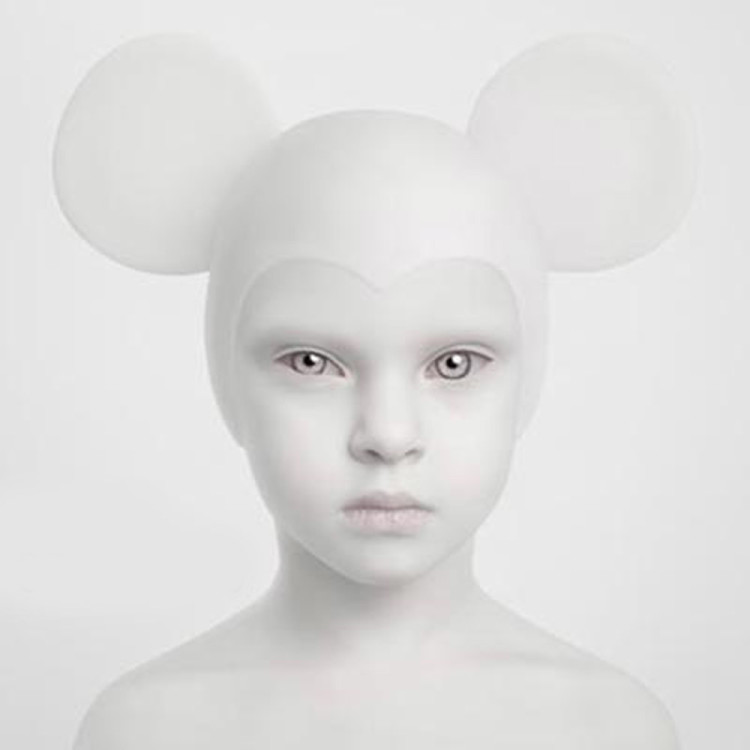
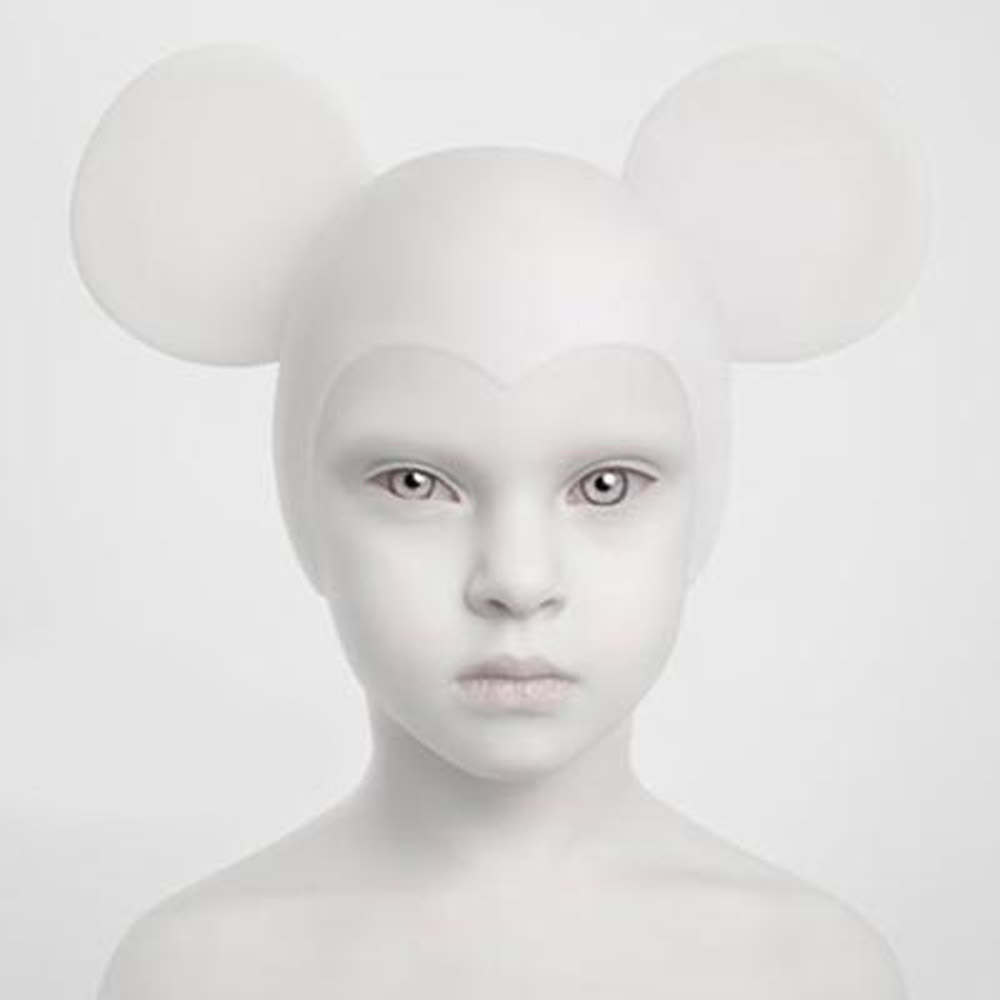
GRIMMLESS
Ricci/Forte Group
Teatro India – Rome
March 29 – April 02, 2011
Text by Roberta d’Errico
Elitist, spiritual, brutal are the adjectives peculiar to the performance played by Ricci/Forte’s.
Elitist means that the audience watching a Ricci/Forte’s performance must not be necessarily an educated or an intellectual person, but must be ready to let himself suck into the turns of the spectacle, coping with the sounds, the images, the actions.
Spiritual means that the Ricci/Forte’s plays have no intention to amuse people or to escape from everyday life, but be a path of personal and collective inner research.
Brutal means that a merciless and straightforward look into the apprehensions of the contemporary man is given. The two directors’ research fit into nearly all the remarks upon the second avant-garde theatre, but the stage phrasing is quite original.
The performance’s main theme is based on the land of make-believe or apparent deprivation as stated by the title. Currently the performance is an immersion into the most famous fairy-tales of Grimm brothers without the brothers and therefore with no rewriting, along a pathway a rebours (wrong way), in an effort to win back the storytelling universe which can be drawn from, in order to think over the contemporary real life.
Since its start the suggestive part connoting the set is represented by several wrappers lit up inside and placed on the stage. They are like shells, larvae of an unknown animal that come down by ropes. Looking carefully we discover that are crystal chandelier just like those we see or imagine into the princely mansions. The wrapper is made of transparent plastic and it expresses the choking of a dream, the impossibility to live a magic dimension. On the right wall of the stage by contrast there is a line of monitors with no programmes.
The visual suggestion is cut off by the irruption among the audience of two actors that have on diving masks and oxygen tubes. They run among the audience with obsessive resolution, almost without breathing, have photos taken by turns with some spectators chosen by chance, and each picture is joined by a sentence that depicts a wedding party typical situation, where even the farthest and unknown persons satisfy their own need for affection and earn the merit to have their own photos taken.
An other actor comes on stage and fires a gun shot making the whirling bustle about of the two actors break off. It is difficult to sketch the string of actions which follow each other giving them a sharp meaning. It is easier to talk of feel and images.
Two other actors come up on stage and altogether put themselves in line and start speaking in turn and therefore give us back snatches of our actuality and, first of all, the facebook world, which constrains us to a synthesis voided of any sense and content. By a remote control, a symbol of the remarks and self-consciousness end, the actors change music and the action is stopped to start again into a new pathway.
All of a sudden the actors lift up the chandeliers and let them swing just like axes. An actor passes through them trying to get unhurt. Afterwards, again they put themselves in line, at the back of the stage, each one of them get a different coloured suitcase. During the whole performance the suitcases will have a privileged role just like characters. They contain things and clothes which will be useful to the actors for the whole performance. The actors drag the suitcases all around the stage and so even the sound of their movement become a soundtrack for the performance and the opening and closing them becomes a punctuation function to the action on the stage. The actors are travelling, seeking an identity, they are moving in a body like dancers. The performance is characterised by a physicality that upsets every fibre of our being. What the actors do on stage showing us the violence of life is a hardship. The violence reaches an apex when it represents the degeneration of the adolescent play. The actors’ action, the violence of a herd against unarmed being seems to summon the motion picture Death wish (M. Winner, 1974). The magic wands have no more power, they are magnetically attracted by the consuming strength of the screens. The heroes of the most famous Grimm’s fairy tales come out the pages and become common people speaking, at last, about the awareness of sorrow and uncomfortableness for the first time. And so we also ask ourselves who is Cinderella or Snow White. Where is Prince Charming, Mr. Right that saves the dear and kind girl from tight situations and overcome the evil?
One of the actress with a Brechtian scepticism, looks for him among the audience and at the end the appointee, after being crowned, sit down on a side of the stage where he will watch the whole performance helpless.
Ricci/Forte’s performance quicken our interest over the fairy tales through a reading for images, with a creativity that is both astonishing and surprising, most of all when the actors give life to a bed of apples on which they drag by hairs Snow White all over the stage.
Even the image of our country arrives on the scene symbolized by a coffin with the tricolour on top of it.
Once upon a time there was a boot shaped nation …. will be this the fairy tale that we will tell the children yet to come?
As from this vision the hope swells. The actors start to spread the skin one another with a golden ointment. At first the face and their hands, afterwards their bared bodies. They act tenderly, sweetly, joyously, the joy of the resurrection, of the spiritual life. When the ritual is complete, the actors can put on ball gowns and dance happily altogether at last. The snow catch them unexpected and stops the journey into the tales as just into life, where cruelty and unmercifulness, magic and wonder take turns in an unlimited play.
Roberta d’Errico – Theatre Editor
Translated by Salvatore Rollo – at salvatore_rollo@fastwebnet.it
Position the cursor on the images to view captions, click on images to enlarge them.
Posizionare il cursore sulle immagini per leggere le didascalie; cliccare sulle immagini per ingrandirle.
COMPAGNIA RICCI / FORTE
GRIMMLESS
29 marzo – 2 aprile 2011
Teatro India, Via Luigi Pierantoni, 6, Roma
www.ricciforte.com
Testo di Roberta d’Errico
Elitario, spirituale, crudele. Questi gli aggettivi che contengono la specificità dello spettacolo della compagnia Ricci/Forte.
Elitario nel senso che lo spettatore che assiste ad una rappresentazione dei Ricci/Forte non deve essere necessariamente colto o intellettuale, ma pronto a lasciarsi trascinare nelle pieghe dello spettacolo, respirandone i suoni, le immagini, le azioni.
Spirituale perché il teatro dei Ricci/Forte non ha come fine il divertimento o l’evasione, ma un percorso di ricerca interiore personale e collettivo.
Crudele, nell’offrire uno sguardo spietato e onesto sulle inquietudini dell’uomo contemporaneo. La ricerca dei due registi si inserisce nell’ eredità di quasi tutte le riflessioni del teatro della seconda avanguardia, ma il fraseggio scenico è del tutto originale.
Il tema centrale della rappresentazione ruota attorno al mondo delle fiabe e alla loro apparente privazione, come recita il titolo. In realtà lo spettacolo è un’immersione nelle fiabe più celebri dei fratelli Grimm, ma senza i Grimm e quindi senza riscritture, in un percorso a rebours, nel tentativo di riconquistare un universo di narrazione cui attingere per riflettere sulla realtà contemporanea.
L’elemento suggestivo che connota l’apparato scenico fin dall’inizio è costituito dalla presenza sul palcoscenico di numerosi involucri illuminati dall’interno. Sono come dei bozzoli, larve di un animale sconosciuto che scendono dall’alto, mediante una fune. A guardarli bene, scopriamo che sono dei lampadari di cristallo, proprio come quelli che siamo abituati a vedere o immaginare nei palazzi principeschi. Il materiale che li avvolge, plastica trasparente, esprime il soffocamento di un sogno, l’impossibilità di vivere una dimensione d’incanto. Fa da contrasto, sulla parete destra del palcoscenico, una successione di monitor televisivi senza programmi.
La suggestione visiva è interrotta dall’irruzione in platea di due attori che indossano una maschera subacquea e il tubo dell’ossigeno. Essi corrono tra gli spettatori e con ossessiva determinazione, quasi senza respirare, si fotografano a turno con degli spettatori scelti a caso ed ogni foto è accompagnata da una frase che descrive una situazione tipica delle feste di matrimonio, dove anche le persone più lontane e sconosciute saziano il desiderio di affezione e conquistano il privilegio di essere fotografate.
Un altro attore entra in scena e spara dei colpi di pistola e il vorticoso affannarsi dei due attori si interrompe. Difficile descrivere la puntuale successione delle azioni che si susseguono accostando ad asse un preciso significato. E’ più facile parlare di atmosfere e di immagini.
In scena appaiono altri due attori. Insieme a quelli già presenti, si dispongono in fila e cominciano a parlare a turno riconsegnandoci frammenti della nostra realtà e, primo fra tutti, il mondo di facebook, che ci costringe alla sintesi svuotata di senso ed essenza. Attraverso un telecomando, simbolo della fine della riflessione e dell’autocoscienza, gli attori cambiano musica e l’ azione si ferma per iniziare un percorso nuovo.
Improvvisamente, gli attori tirano su i lampadari e cominciano a farli pendolare, come delle mannaie. Un attore vi passa attraverso cercando di non essere colpito. Poi di nuovo si dispongono in fila, in fondo al palcoscenico, ognuno di loro ha una valigia di colore diverso. Per tutta la rappresentazione le valigie avranno un ruolo privilegiato, come fossero dei personaggi. In esse sono contenuti gli oggetti e gli abiti che serviranno agli attori durante la rappresentazione. Gli attori trascinano con sé le valigie, da una parte all’altra della scena e così anche i rumori del loro movimento diviene una colonna sonora dello spettacolo e il gesto di aprirle e chiuderle diventa una funzione di interpunzione all’azione scenica. Gli attori sono in viaggio, alla ricerca di un’identità, si muovono in gruppo, come in una danza.
Lo spettacolo è caratterizzato da una fisicità che scuote ogni nostra fibra. E’ un sacrificio quello che gli attori compiono in scena per mostrarci la violenza di cui è intessuta la vita. La violenza raggiunge l’apice quando si rappresenta lo slittamento e la degenerazione del gioco adolescenziale. L’azione degli attori, la violenza del branco su un essere indifeso sembra rievocare quella della sequenza del celebre film Il giustiziere della notte ( Michael Winner, 1974).
Le bacchette magiche non hanno più potere, sono attratte magneticamente dalla potenza divoratrice degli schermi. I protagonisti delle più celebri fiabe dei fratelli Grimm escono dalle pagine e diventano persone comuni che parlano, finalmente, per la prima volta del dolore e del disagio della consapevolezza. E così anche noi per la prima volta ci chiediamo chi siano Biancaneve o Cenerentola. Dov’è il principe azzurro che salva la dolce e buona fanciulla dalle situazioni di pericolo e che fa trionfare il bene sul male? Una delle attrici, con un brechtiano disincanto, lo cerca in platea e alla fine il designato, dopo essere stato incoronato, viene fatto sedere a lato del palcoscenico da dove assisterà, inerme, allo spettacolo per tutta la sua durata.
Lo spettacolo dei Ricci/Forte risveglia il nostro sguardo sulle fiabe attraverso una interpretazione per immagini, con una creatività che stupisce e meraviglia, più di tutte quella che vede gli attori dare vita ad un letto di mele sulle quali fanno scivolare lungo il palcoscenico il personaggio di Biancaneve tirata per i capelli.
Anche l’immagine del nostro paese entra in scena simboleggiato da una bara con sopra il tricolore. C’era una volta un paese a forma di stivale…sarà questa la fiaba da raccontare ai bambini che verranno?
Da questa visione risorge la speranza. Gli attori iniziano a spalmarsi vicendevolmente sulla pelle un unguento dorato. Prima sul volto e sulle mai, poi sui loro corpi denudati. Compiono questo gesto con dolcezza, con gioia, la gioia della resurrezione, della vita spirituale. Completato il rituale, gli attori possono finalmente indossare abiti da ballo e danzare insieme felicemente. La neve li coglie all’improvviso e chiude il viaggio nelle fiabe così come nella vita, dove crudeltà e spietatezza, incanto e meraviglia alternano un gioco infinito.
Roberta d’Errico
Theatre Editor
http://vimeo.com/ricciforte
ricci/forte press office: Francesco Paolo Del Re
mob. +39 320 0823405 – mob. +39 392 8918793

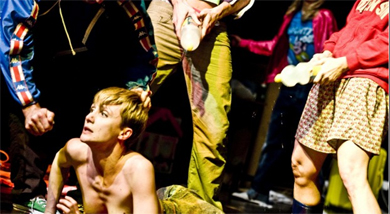
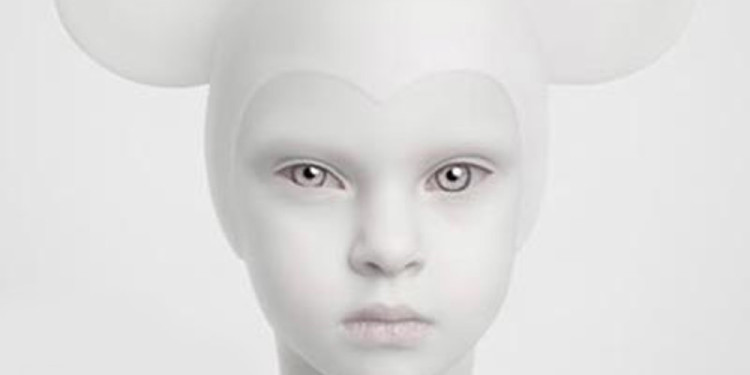
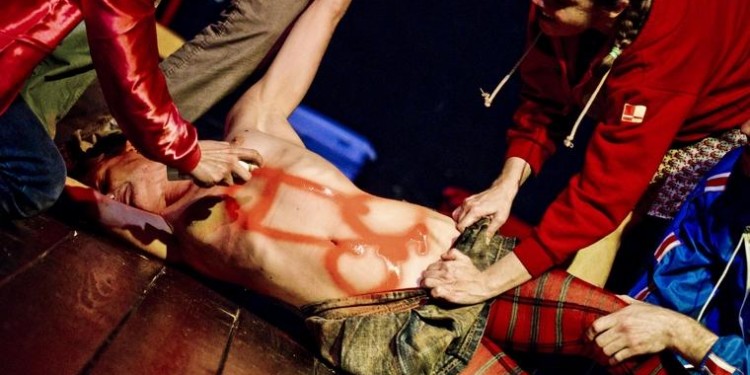
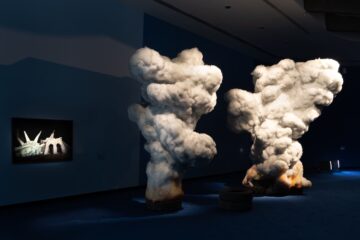


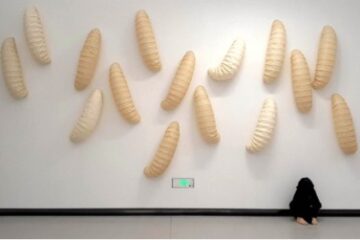

No Comment